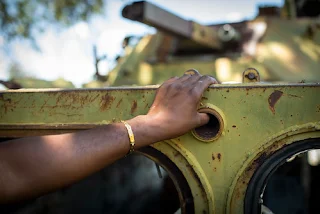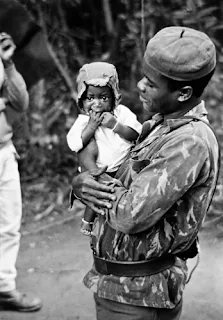Landmines and Child Soldiers in the Angolan Civil War
During the 27 Year Long Angolan Civil War both the government and rebel groups used child soldiers to fight their battles.
Angolan Civil War and war repercussions for the average Angolan.
The Angolan Civil War was a long-lasting conflict that lasted from 1975 to 2002. The war began immediately after Angola gained independence from Portugal and was fought between three main factions: the Popular Movement for the Liberation of Angola (MPLA), the National Union for the Total Independence of Angola (UNITA), and the National Liberation Front of Angola (FNLA). The war had severe consequences for the average Angolan, as the conflict led to widespread violence, displacement, and economic disruption.
Angolan Civil War, spanning from 1975 to 2002, both governmental forces and rebel groups employed child soldiers in their armed engagements.
The Angolan Civil War began in 1975 when the three factions, MPLA, UNITA, and FNLA, began fighting for control over Angola. The MPLA emerged as the victor, and its leader, Agostinho Neto, became the first president of Angola.
UNITA and FNLA refused to recognize the MPLA government and continued fighting against it. This led to a prolonged period of instability, as the MPLA government struggled to maintain control over the country.
The conflict intensified in the 1980s when UNITA received military support from South Africa and the United States. This aid allowed UNITA to become a formidable military force and posed a significant threat to the MPLA government.
The conflict led to widespread violence, with both sides committing numerous human rights violations, including massacres of civilians, torture, and forced displacement.
In 1991, the MPLA government and UNITA signed a peace agreement that called for a ceasefire and democratic elections. However, the peace process broke down, and the war resumed in 1992.
The conflict once again intensified, leading to widespread violence and displacement. The war also had a severe economic impact, with infrastructure and agricultural production severely disrupted, leading to food shortages and famine.
The war continued into the 2000s, with the MPLA government gaining the upper hand with the support of Cuban troops. In 2002, UNITA leader Jonas Savimbi was killed in battle, leading to a ceasefire and the official end of the conflict. The MPLA government remained in power, and the country began a slow process of reconstruction and recovery.
The war had severe consequences for the average Angolan, with widespread violence and displacement. The conflict caused significant damage to infrastructure and agriculture, leading to food shortages and famine. The war also had a severe impact on the country's economy, with resources diverted to the military and productive industries severely disrupted.
Liberation movements fought Government forces in the Portuguese dominated territories in African throughout the 1960’s and 1970’s. In the words of the Angolan Leader, Agostinho Neto, they worked "to free and modernize our peoples by a dual revolution-against their traditional structure which can no longer serve them and against colonial rule".
From Playgrounds to Battlefields the use of Child Soldiers in Angolan Civil War.
The use of child soldiers was a significant aspect of the Angolan Civil War, and it had devastating consequences for the children involved. Child soldiers were used by both the MPLA and UNITA forces, as well as other armed groups operating in the country.
Children were often forcibly recruited into the military, taken from their families or abducted from their villages. Some children joined voluntarily, either out of a desire for adventure or because they saw no other way to survive. Once recruited, child soldiers were trained to fight and often sent to the front lines of the conflict.
The use of child soldiers was widespread in the civil war, with estimates suggesting that tens of thousands of children were involved. Many children were subjected to physical and emotional abuse, including beatings and torture, and were often forced to commit atrocities against civilians.
The consequences of the use of child soldiers were severe. Many children were killed or injured in the conflict, and those who survived suffered from physical and mental health problems, including post-traumatic stress disorder (PTSD) and depression. The use of child soldiers also had a lasting impact on the social fabric of Angolan society, as it disrupted families and communities.
The recruitment of child soldiers was outlawed by the United Nations Convention on the Rights of the Child in 1989, and Angola is a signatory to this convention. However, the practice continued throughout the civil war, and even after the conflict ended, many former child soldiers struggled to reintegrate into society.
Efforts have been made to address the issue of child soldiers in Angola. In 2007, the government passed a law criminalizing the recruitment of child soldiers, and a program was established to demobilize former child soldiers and provide them with education and job training. NGOs such as UNICEF and Save the Children have also been active in providing support to former child soldiers and advocating for their rights.
The Human Toll of Landmines in Angola.
Landmines were widely used during the Angolan Civil War, and their impact on the country and its people was severe. Both government forces and rebel groups used landmines as a weapon of war, and Angola became one of the most heavily mined countries in the world.
Landmines were used to control territory and to disrupt supply lines, as well as to inflict casualties on enemy forces. They were often laid indiscriminately, without regard for the safety of civilians, and many were left behind after the conflict ended, causing ongoing harm.
The impact of landmines on civilians was particularly devastating. Landmines were responsible for the deaths and injuries of thousands of Angolans, many of whom were children. Landmines also made it difficult for farmers to cultivate their land, which had a significant impact on the country's food security.
The legacy of landmines in Angola continues to be felt today, with an estimated 10-20% of the country's population living in areas contaminated by landmines. Efforts have been made to clear landmines, but progress has been slow, and many areas remain unsafe.
In response to the widespread use of landmines in Angola, the country became a signatory to the Ottawa Treaty in 2002, which bans the use, stockpiling, production, and transfer of landmines. Angola has also been active in international efforts to address the issue of landmines, and it has received support from the United Nations and other international organizations in its efforts to clear landmines and provide assistance to victims.
In 2023 Angola is still recovering from the effects of the civil war.
The Angolan Civil War led to the displacement of millions of people, with many forced to flee their homes and communities. The war also led to the widespread use of child soldiers, with both sides recruiting children as young as 10 years old to fight in the conflict.
The children who were recruited as child soldiers suffered from physical and psychological abuse, including beatings, forced labor, and exposure to violence. They were also subjected to indoctrination and forced to commit atrocities, including killing civilians and other children.
Following the end of the war in 2002, efforts were made to disarm and demobilize the child soldiers. The United Nations and other international organizations played a key role in these efforts, working with the Angolan government to develop programs to rehabilitate and reintegrate former child soldiers into their communities.
These programs included providing psychological counseling and support to help the children overcome the trauma of their experiences. They also provided education and vocational training to help the children acquire new skills and prepare for a new life outside of the military.
However, the reintegration process was not always successful, and many former child soldiers faced ongoing challenges in their efforts to rebuild their lives. Some children faced discrimination and stigma from their communities due to their past involvement in the conflict. Others struggled with ongoing psychological trauma and had difficulty adapting to civilian life.
The war also had severe consequences for public health, with widespread violence leading to increased rates of injury and death. The conflict also disrupted health services, leading to the spread of diseases such as cholera and malaria.
The war had a severe impact on education, with many schools closed or destroyed. This led to widespread illiteracy and a significant impact on the country's future development. The war also had a severe impact on cultural heritage, with many cultural sites destroyed or damaged.
The legacy of the Angolan Civil War continues to be felt in the country today. The war left behind a legacy of poverty, inequality, and underdevelopment, with many communities still struggling to recover from the conflict. The country remains one of the poorest in the world, with high rates of child mortality, illiteracy, and poverty.
The Angolan Civil War was a long-lasting conflict that had severe consequences for the average Angolan. The war led to widespread violence, displacement, and economic disruption, with significant impacts on public health, education, and cultural heritage. The legacy of the conflict continues to be felt in the country today, with many communities still struggling.
Today, the legacy of the Angolan Civil War continues to be felt in Angola, with the use of child soldiers and landmines remaining a painful reminder of the conflict's human cost. Despite efforts to disarm and rehabilitate former child soldiers and clear landmines, the ongoing effects of the conflict continue to be felt by the people of Angola.
More links to articles you will find thought provoking.
- Dangerous Erupting Volcanoes of Africa

- Top 20 Largest Countries in Africa

-
What is an African Proverb

- African Water Spirit Mami Wata

-
Ancestors are Guardian Angels








